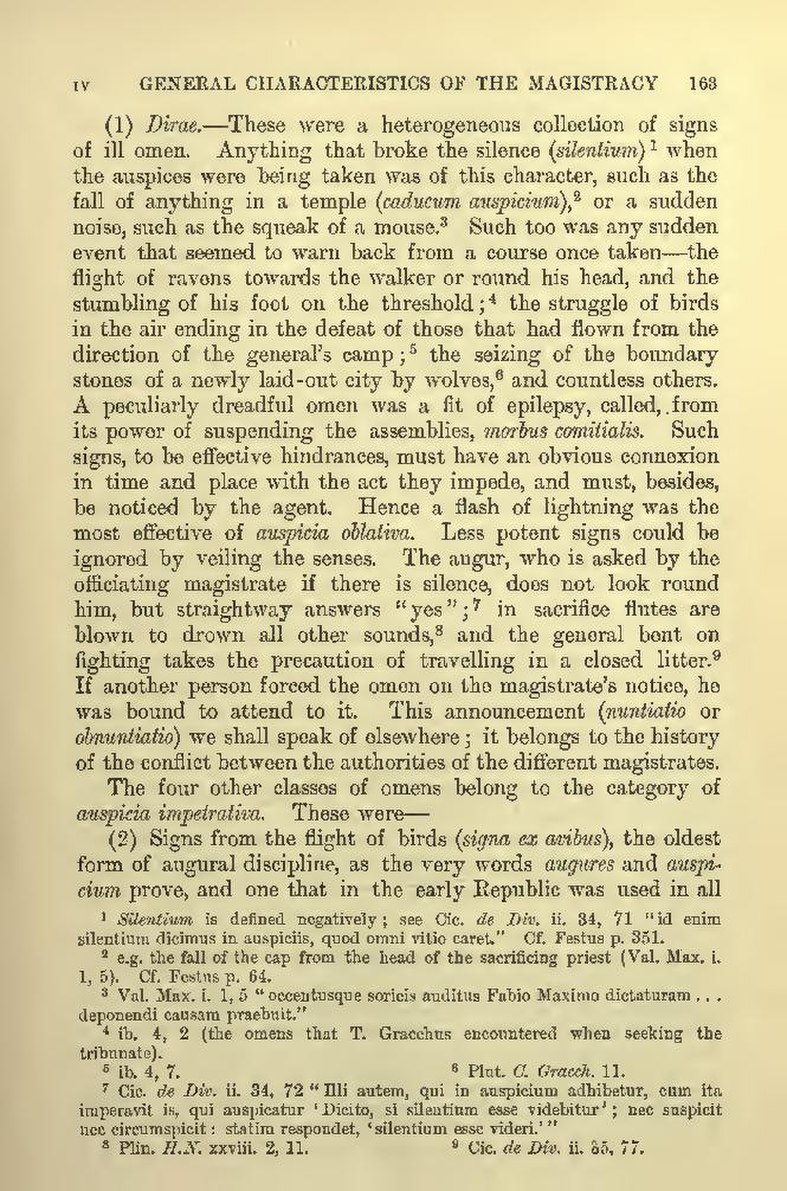(1) Dirae.—These were a heterogeneous collection of signs of ill omen. Anything that broke the silence (silentium)[1] when the auspices were being taken was of this character, such as the fall of anything in a temple (caducum auspicium),[2] or a sudden noise, such as the squeak of a mouse.[3] Such too was any sudden event that seemed to warn back from a course once taken—the flight of ravens towards the walker or round his head, and the stumbling of his foot on the threshold;[4] the struggle of birds in the air ending in the defeat of those that had flown from the direction of the general's camp;[5] the seizing of the boundary stones of a newly laid-out city by wolves,[6] and countless others. A peculiarly dreadful omen was a fit of epilepsy, called, from its power of suspending the assemblies, morbus comitialis. Such signs, to be effective hindrances, must have an obvious connexion in time and place with the act they impede, and must, besides, be noticed by the agent. Hence a flash of lightning was the most effective of auspicia oblativa. Less potent signs could be ignored by veiling the senses. The augur, who is asked by the officiating magistrate if there is silence, does not look round him, but straightway answers "yes";[7] in sacrifice flutes are blown to drown all other sounds,[8] and the general bent on fighting takes the precaution of travelling in a closed litter.[9] If another person forced the omen on the magistrate's notice, he was bound to attend to it. This announcement (nuntiatio or obnuntiatio) we shall speak of elsewhere; it belongs to the history of the conflict between the authorities of the different magistrates.
The four other classes of omens belong to the category of auspicia impetrativa. These were—
(2) Signs from the flight of birds (signa ex avibus), the oldest form of augural discipline, as the very words augures and auspicium prove, and one that in the early Republic was used in all
- ↑ Silentium is defined negatively; see Cic. de Div. ii. 34, 71 "id enim silentium dicimus in auspiciis, quod omni vitio caret." Cf. Festus p. 351.
- ↑ e.g. the fall of the cap from the head of the sacrificing priest (Val. Max. i. 1, 5). Cf. Festus p. 64.
- ↑ Val. Max. i. 1, 5 "occentusque soricis auditus Fabio Maximo dictaturam . . . deponendi causam praebuit."
- ↑ ib. 4, 2 (the omens that T. Gracchus encountered when seeking the tribunate).
- ↑ ib. 4, 7.
- ↑ Plut. C. Gracch. 11.
- ↑ Cic. de Div. ii. 34, 72 "Illi autem, qui in auspicium adhibetur, cum ita imperavit is, qui auspicatur 'Dicito, si silentium esse videbitur'; nec suspicit nec circumspicit: statim respondet, 'silentium esse videri.'"
- ↑ Plin. H.N. xxviii. 2, 11.
- ↑ Cic. de Div. ii. 35, 77.
